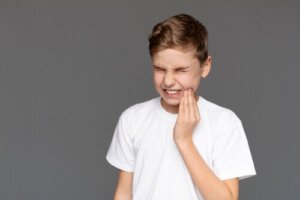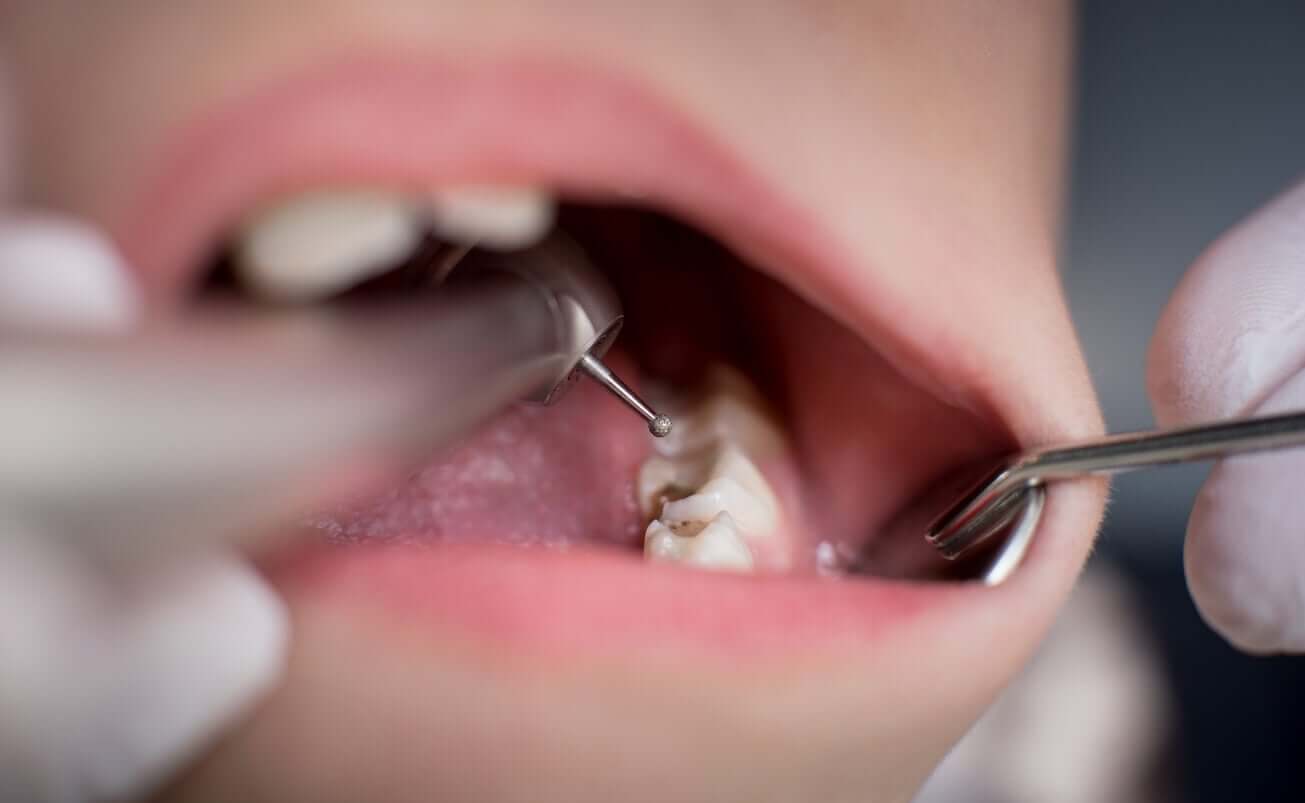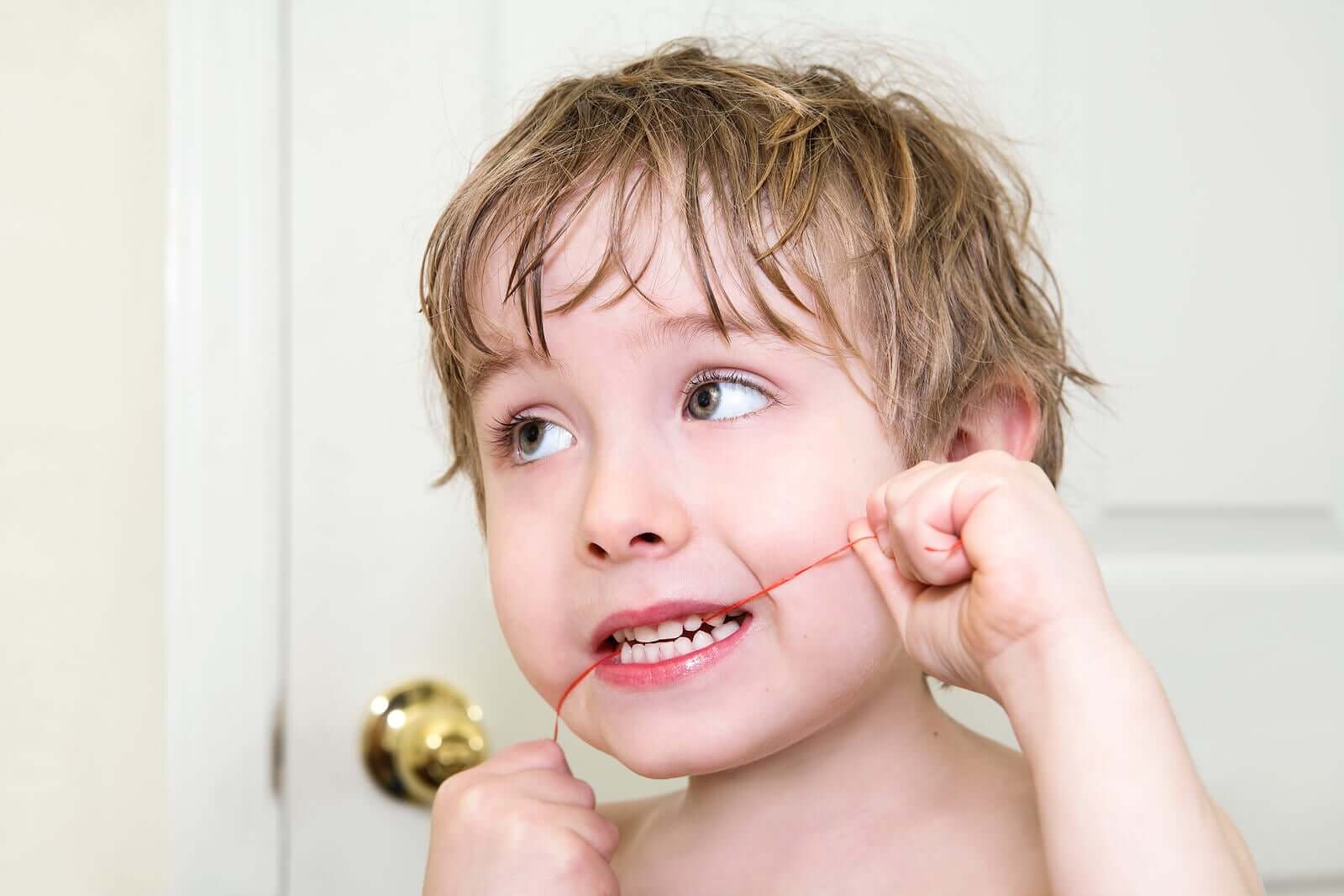How to Soothe Tooth Pain Due to Cavities in Children?

Injuries to infants’ teeth can cause discomfort and make it difficult to eat. Therefore, many adults seek solutions to soothe tooth pain due to cavities in their children.
In this article, we’ll tell you how to identify these types of injuries and also what to do to help your child feel better. Keep reading!
Symptoms of cavities in children
Tooth decay is one of the most common diseases in the world and affects both adults and children. It can even develop as soon as teeth appear in the mouth.
This condition is characterized by the loss of the hard tissues of the tooth, due to the action of the acids produced by the bacteria that inhabit this cavity. In general, this phenomenon is closely related to a high intake of carbohydrates in the diet.
As the disease progresses, the teeth deteriorate until they’re destroyed. When there’s a perforation in the teeth, the injury can affect the dental pulp and cause various types of discomfort in the mouth. Among them, pain or interference with some oral functions.
It’s important for parents to take their children to the dentist regularly in order to detect any oral problems early and offer an immediate solution. In this way, they prevent the profession of the process to more painful stages.
Also, you need to pay attention to the appearance of the teeth of little ones. Tooth decay manifests itself as spots, which are white at first and then turn brown or black. Also, they can appear as holes on the surfaces of teeth.
More advanced cases can lead to other complications, such as infections or inflammation of the nerve. These phenomena are manifested through an increase in sensitivity, pain, fistulas with pus, swelling of the face, and even fever. In these cases, it’s important to go to the dentist urgently.

Strategies to soothe tooth pain from cavities
The first action to take to calm tooth pain due to cavities in children is to schedule an appointment with the pediatric dentist. The professional’s evaluation will allow an accurate diagnosis and start the most appropriate treatment as soon as possible.
However, until the dental appointment is made, some of these measures can be put into practice to offer relief to little ones:
- Brush teeth thoroughly, with a soft bristle brush and fluoride toothpaste. Many times, when the lesions are large, the remains of food and bacterial plaque remain trapped in these cavities. This causes discomfort, which is alleviated by removing debris and cleaning the teeth.
- Applying cold to a child’s face can soothe a toothache. This method is often useful, especially when there’s swelling on the cheeks.
- Rinses with water and salt: When there’s a lot of accumulated bacterial plaque or infections with pus occur, swishing with warm water and salt can help reduce discomfort in the mucosa. These rinses can be done 2-3 times a day and it’s important to remind your little one not to swallow them.
- Using pain relievers: Your doctor or dentist can be consulted before giving over-the-counter pain relievers, such as ibuprofen or acetaminophen. It’s important not to self-medicate the child and to check with a professional about the appropriate dose.
If the child has a fever, has a swollen face or neck, or has difficulty speaking or swallowing, they should go to the hospital immediately. These symptoms may reveal a soft tissue infection that must be treated quickly.
How to prevent cavities in children
Tooth decay is a pathology that can be prevented with the practice of certain healthy habits. Caring for the mouths of children is a responsibility that falls on their parents, so they must be attentive to their care from birth.
Oral hygiene begins before the first teeth appear in the mouth, by cleaning the baby’s gums with a piece of gauze.
When the first dental elements erupt, you need to begin with tooth brushing. The same is done with a brush for children that’s small and has soft bristles.
Adults must clean the child’s teeth, gums, and tongue in order to reach all the sides of the teeth. The use of fluoride toothpaste is also important, with the recommended doses for each age and dental floss.
It’s important to brush for at least 2 minutes and 3 times a day, at least. Adults should perform hygiene until children can do it themselves, which occurs between 6 and 8 years. After this time, they must supervise to make sure that children have the right technique so as not to neglect oral health.
Taking care of your diet is also important for proper oral health. In this regard, it’s important to avoid the consumption of foods that are rich in sugar, such as sweets and soft drinks.
Going to the dentist from the first year of life and continuing regular visits is another way to avoid cavities. The dentist checks the condition of the mouth, detects any problems early, and applies preventive measures, such as sealants and fluoride. In addition, they advise parents regarding the measures to implement in order to take care of the smile of their little ones.

The role of parents in oral care
As you’ve seen, with responsible parents, it’s possible to avoid cavities in children. And with proper prevention, you won’t even need to think about how to soothe tooth pain from cavities.
Injuries to infants’ teeth can cause discomfort and make it difficult to eat. Therefore, many adults seek solutions to soothe tooth pain due to cavities in their children.
In this article, we’ll tell you how to identify these types of injuries and also what to do to help your child feel better. Keep reading!
Symptoms of cavities in children
Tooth decay is one of the most common diseases in the world and affects both adults and children. It can even develop as soon as teeth appear in the mouth.
This condition is characterized by the loss of the hard tissues of the tooth, due to the action of the acids produced by the bacteria that inhabit this cavity. In general, this phenomenon is closely related to a high intake of carbohydrates in the diet.
As the disease progresses, the teeth deteriorate until they’re destroyed. When there’s a perforation in the teeth, the injury can affect the dental pulp and cause various types of discomfort in the mouth. Among them, pain or interference with some oral functions.
It’s important for parents to take their children to the dentist regularly in order to detect any oral problems early and offer an immediate solution. In this way, they prevent the profession of the process to more painful stages.
Also, you need to pay attention to the appearance of the teeth of little ones. Tooth decay manifests itself as spots, which are white at first and then turn brown or black. Also, they can appear as holes on the surfaces of teeth.
More advanced cases can lead to other complications, such as infections or inflammation of the nerve. These phenomena are manifested through an increase in sensitivity, pain, fistulas with pus, swelling of the face, and even fever. In these cases, it’s important to go to the dentist urgently.

Strategies to soothe tooth pain from cavities
The first action to take to calm tooth pain due to cavities in children is to schedule an appointment with the pediatric dentist. The professional’s evaluation will allow an accurate diagnosis and start the most appropriate treatment as soon as possible.
However, until the dental appointment is made, some of these measures can be put into practice to offer relief to little ones:
- Brush teeth thoroughly, with a soft bristle brush and fluoride toothpaste. Many times, when the lesions are large, the remains of food and bacterial plaque remain trapped in these cavities. This causes discomfort, which is alleviated by removing debris and cleaning the teeth.
- Applying cold to a child’s face can soothe a toothache. This method is often useful, especially when there’s swelling on the cheeks.
- Rinses with water and salt: When there’s a lot of accumulated bacterial plaque or infections with pus occur, swishing with warm water and salt can help reduce discomfort in the mucosa. These rinses can be done 2-3 times a day and it’s important to remind your little one not to swallow them.
- Using pain relievers: Your doctor or dentist can be consulted before giving over-the-counter pain relievers, such as ibuprofen or acetaminophen. It’s important not to self-medicate the child and to check with a professional about the appropriate dose.
If the child has a fever, has a swollen face or neck, or has difficulty speaking or swallowing, they should go to the hospital immediately. These symptoms may reveal a soft tissue infection that must be treated quickly.
How to prevent cavities in children
Tooth decay is a pathology that can be prevented with the practice of certain healthy habits. Caring for the mouths of children is a responsibility that falls on their parents, so they must be attentive to their care from birth.
Oral hygiene begins before the first teeth appear in the mouth, by cleaning the baby’s gums with a piece of gauze.
When the first dental elements erupt, you need to begin with tooth brushing. The same is done with a brush for children that’s small and has soft bristles.
Adults must clean the child’s teeth, gums, and tongue in order to reach all the sides of the teeth. The use of fluoride toothpaste is also important, with the recommended doses for each age and dental floss.
It’s important to brush for at least 2 minutes and 3 times a day, at least. Adults should perform hygiene until children can do it themselves, which occurs between 6 and 8 years. After this time, they must supervise to make sure that children have the right technique so as not to neglect oral health.
Taking care of your diet is also important for proper oral health. In this regard, it’s important to avoid the consumption of foods that are rich in sugar, such as sweets and soft drinks.
Going to the dentist from the first year of life and continuing regular visits is another way to avoid cavities. The dentist checks the condition of the mouth, detects any problems early, and applies preventive measures, such as sealants and fluoride. In addition, they advise parents regarding the measures to implement in order to take care of the smile of their little ones.

The role of parents in oral care
As you’ve seen, with responsible parents, it’s possible to avoid cavities in children. And with proper prevention, you won’t even need to think about how to soothe tooth pain from cavities.
All cited sources were thoroughly reviewed by our team to ensure their quality, reliability, currency, and validity. The bibliography of this article was considered reliable and of academic or scientific accuracy.
- Acosta, K. P., Baez, F. A. G., Rodríguez, Y. L., & González, S. E. (2018). Urgencias por caries dental en escolares de 5 a 11 años de edad. Medimay, 25(3), 223-233.
- Ordoñez, K. Z., & Urgiles, C. (2020). Impacto de la caries dental en la calidad de vida en niños de 11 a 12 años de la Unidad Educativa Dolores J Torres, Parroquia Sagrario, Cuenca. Revista KIRU, 17(2).
- Aguilar Cueva, P. C., & Asencios Felix, R. R. (2019). Impacto de la salud oral en la calidad de vida en niños de la Institución Educativa Inicial 336-Ocopilla.
- Berenice, V. R. S., Alberto, B. G. R., Abraham, A. S. J., & Alejandra, M. M. (2016). Prevalencia y severidad de caries dental en niños de 0 a 12 años. Revista Tamé, 5(13), 459-462.
- Ttito, R. G. L. (2019). Nivel de conocimiento de las madres sobre medidas preventivas de caries dental en niños menores de 5 años del Centro de Salud de Chocco Cusco, 2018. Visión Odontológica, 6(1), 76-79.
- Soria-Hernández, M. A., Molina, N., & Rodríguez, R. (2008). Hábitos de higiene bucal y su influencia sobre la frecuencia de caries dental. Acta pediátrica de México, 29(1), 21-24.
- García-Vega, L. (2015). Relación entre consumo de alimentos cariogénicos e higiene bucal con caries dental en escolares. Revista KIRU, 9(1).
- Cuartas, J. C., Ospina, A. M. A., Maya, A. M., Cárdenas, J. M., Arias, M. I., & Jaramillo, A. (2002). Relación entre percepción de los padres sobre el tratamiento odontológico y sus hábitos de higiene oral, con la historia de caries dental en sus hijos, entre 3 y 5 años de edad. CES Odontología, 15(1), 13-18.
This text is provided for informational purposes only and does not replace consultation with a professional. If in doubt, consult your specialist.








